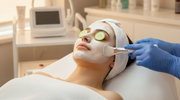Here’s why pigmented skin should steer clear of physical exfoliation

A GRITTY FACE SCRUB CLAIMS TO ‘BRIGHTEN’ YOUR SKIN BUT WHAT IF WE TOLD YOU THAT IT DOES THE EXACT OPPOSITE?
Ask a beauty aficionado to name their skincare pet peeve and the probability of “apricot scrubs” surfacing as the answer is quite high. Did you know that there was a lawsuit filed against the once-upon-a-time global-favourite Apricot Scrub by St. Ives in 2016 for damaging the skin [of the plaintiffs] dreadfully? While face scrubs don’t deserve to be banned entirely, each person’s interaction with the product is different and subject to factors like skin type, skin conditions, the intensity of abrasiveness, formulation of the scrub and the frequency and fashion of use. Hence, while proscribing the face scrub category isn’t a mandate for every skin type, skin prone to hyperpigmentation must abstain from them.
HYPERPIGMENTATION 101
While hyperpigmentation is largely visible at a skin-deep level, it’s a slightly layered concept. “Pigmentation is the presence of colour. When the colour exceeds, it is called hyperpigmentation. This can manifest as tiny freckles or lentigines, islands of colour change like melasma or vague patches of increased colour like tanning,” explains New Delhi-based dermatologist and co-founder of Sarin Skin Solutions, Dr Jushya Sarin.

Pigmentation is the presence of colour. When the colour exceeds, it is called hyperpigmentation, says Dr Jushya Sarin. Image: Pexels

Face scrubs have a bad reputation for creating micro-tears in the skin, and only grow (them) in size and number with time. Image: Pexels
“To understand how the melanin in the skin works, dermatologists have a basic classification of skin types, called the Fitzpatrick classification. The two extreme skin types (sitting at both ends of the scale) are skin type I, which includes those with pale skin, blonde hair and blue eyes, with the lowest melanin in the skin, and skin type VI, with the deepest skin tone. Indian skin types lie somewhere between skin types III and V, sometimes even VI,” reveals dermatologist Dr Renita Rajan. Explaining why hyperpigmentation is common in Indian skin, Mumbai-based celebrity dermatologist Dr Madhuri Agarwal says, “Indians commonly have richer complexions. The darker the skin type, the larger and more in number are melanocytes, or the skin colour-producing cells.” Enumerating other common causes of hyperpigmentation in the skin, she mentions exacerbating sun exposure and UV damage, hormonal disruption, certain medication and skin disorders.
WHY PHYSICAL SCRUBS AND HYPERPIGMENTATION DON’T ALIGN
“It is very important for us [Indians] to have enough melanin with our high levels of sun exposure as a tropical country, as melanin is what stands between our skin and skin cancer. Because of this and factors like more sebum secretion, our skin behaves quite differently from the skin of those in the West,” cites Rajan. “So while dry brushing, exfoliation, loofahs, apricot and walnut scrubs are somewhat useful for Western skin, closer home, for our pigmented skin types, physical scrubs are irrelevant and even worse, counterproductive,” she furthers.
“PHYSICAL SCRUBS CAUSE MICRO-TEARS AND SKIN INFLAMMATION. ANY KIND OF INFLAMMATION OR INJURY IN THE CASE OF INDIAN SKIN HAS THE TENDENCY TO HEAL WITH PIGMENTATION”Dr Madhuri Agarwal
It’s no secret that face scrubs have a bad reputation for creating micro-tears in the skin, and only grow in size and number with time. The development of micro-tears also sows the seeds for trauma. “Physical scrubs cause micro-tears and skin inflammation. Any kind of inflammation or injury in the case of Indian skin has the tendency to heal with pigmentation. This gradually aggravates pigmentation, which becomes visible after a certain time,” explains Agarwal. In concurrence, Rajan states that this phenomenon occurs because melanin is hugely involved in the process of recovery and repair in response to trauma in our skin.
IS CHEMICAL EXFOLIATION ANY BETTER?
According to Sarin, exfoliation is a double-edged sword for skin with hyperpigmentation. “If done the right way, it can exfoliate the skin cells holding the pigment, thereby curtailing the appearance of the skin, and if overdone, it can act like a stimulus for more pigment production.” However, Agarwal is of the opinion that exfoliation will just reduce the build-up of dead cells and improve skin health and not actively aid with hyperpigmentation as such. However, reduced pigmentation does come as a spin-off of chemical exfoliation (when done correctly), directly or indirectly. Here are some things to be wary of before opting for chemical exfoliation:
-
Pick your weapon carefully: Pigmented skin can be oily, combination, sensitive and dry. So it’s crucial to pick an active that suits your skin type. For instance, BHAs like salicylic acid unclogs pores and decongest the skin whereas AHAs like glycolic acid and lactic acid provide gentle exfoliation and resurfacing.
-
Indulge in adequate before and after care: Chemical exfoliation isn’t a no-brainer ritual, like applying moisturiser. You must use a treatment lotion or serum on damp skin for optimal absorption and layer a deeply nourishing face cream to minimise dryness and irritation.
-
Be mindful of the wear time: Besides active-infused serums, chemical peels (the 30% AHA and 2% BHA Peeling Solution from The Ordinary, for instance) are another medium to explore chemical exfoliation, providing instant results. However, “chemical peels get their work done in a matter of minutes as they are expected to work only on the top few layers. Leaving them on for longer adds nothing beneficial, but may worsen sensitivity due to the unnecessary contact of the acids with the skin,” says Rajan.

The AHA/BHA Daily Cleansing Gel from Dr Dennis Gross allows you to provide your skin with mild chemical exfoliation without having the product to stay on the skin for long Image: instagram.com/drdennisgross

The 2% BHA toner contains salicylic acid a.k.a the ultimate pore-cleaning agent along with papaya enzyme and moringa water and moringa seed extract to purify, refine and decongest the pores, thereby reduce sebum. Image: instagram.com/farmacybeauty
WHAT LIES AHEAD
Upon being asked to shed light on the tried-and-tested preventive and reparative measures to tackle hyperpigmentation, all three dermatologists had one common piece of advice—don’t skimp on sunscreen. “Use a Vitamin C or ferulic acid serum in the morning before sun exposure to reduce the existing pigmentation. At night, make sure to remove your sunscreen and make-up thoroughly and use a mild cream containing kojic acid, azelaic acid or arbutin that addresses pigmentation. Glutathione is a powerful antioxidant that will help too,” suggests Agarwal. She furthers, “Besides products, it is advisable to do regular sessions of chemical peels and lasers at least once a month to treat all types of pigmentation. The Yavana Peau Claire is a popular treatment that takes off the tan, reduces pigmentation and brightens the skin.” Sarin also encourages trying laser-toning or chemical peels at a dermatologist’s clinic and limiting sun exposure.
Read full article on : https://www.theestablished.com/self/heres-why-pigmented-skin-should-steer-clear-of-physical-exfoliation


